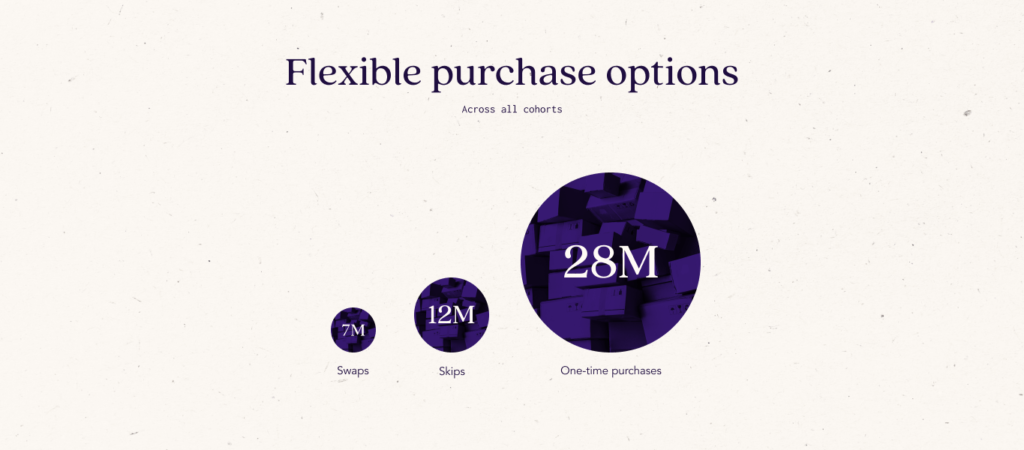More and more, the subscription business model is gaining traction over traditional business models. The subscription economy is predicted to reach $2.64 trillion by 2028, and the subscription business model offers merchants enormous opportunities for recurring revenue growth. For customers, subscriptions also offer value in the form of cost savings and convenience.
When analyzing subscription merchants’ performance, GMV, or gross merchandise value, can’t be overlooked. Because it considers both the volume and value of the goods and services sold by a merchant, it directly impacts a merchant’s available resources and business strategy.
In our latest State of Subscription Commerce report, we cover 2021’s key trends in merchant performance, broken down into five different ranges of annual GMV:
- Cohort 1: $100–$100,000
- Cohort 2: $100,001– $500,000
- Cohort 3: $500,001–$1,000,000
- Cohort 4: $1,000,001–$5,000,000
- Cohort 5: $5,000,001+.
What we found: Subscription services’ performance didn’t always align with their GMV range. In terms of certain KPIs (key performance indicators), at times, merchants with a lower GMV range even outperformed their counterparts with higher GMV.
Now, let’s dive deeper into those key subscription metrics and their trends across merchants of varying sizes.
Key takeaways
- Having a higher GMV doesn’t necessarily translate into greater success with the subscription business model.
- In terms of AOV and LTV, merchants with lower GMV outperformed their competitors with higher GMV in 2021.
- Regardless of your GMV, you can empower your subscribers with flexible subscription management options like product skips, order swaps, and one-time purchases.
Performance by GMV range in 2021 for subscription businesses
Here, we’ll focus on three key metrics and their growth in 2021 for brands following subscription business models: average order value (AOV), customer lifetime value (LTV), and subscriber growth.
AOV
Among the merchants we studied, we found that AOV did not show a meaningful correlation to GMV in 2021. In order from highest AOV to lowest AOV, the various cohorts ranked as follows:
- Cohort 2 ($122)
- Cohort 4 ($110)
- Cohort 1 ($79)
- Cohort 5 ($78)
- Cohort 3 ($65)
Why could this have happened? Diving deeper into the makeup of Cohort 2, we discovered that 42% of merchants in this GMV range fell into the Food & Beverage vertical—also the category with the highest AOV.
LTV
Like we saw with AOV, Cohorts 1, 2, and 4 all surpassed Cohort 5 in their LTV. In order from highest AOV to lowest AOV, the various cohorts ranked as follows:
- Cohort 4 ($854)
- Cohort 2 ($761)
- Cohort 1 ($397)
- Cohort 5 ($391)
- Cohort 3 ($346)
What could have explained this breakdown? We found that the majority of merchants in Cohort 4 fall under the Food & Beverage and Health & Wellness verticals, which saw significant spikes in customer growth in the second half of 2021.
The takeaway: To maximize your AOV and LTV, regardless of your GMV, be sure to reward your most loyal subscribers for their efforts. Consider integrations geared toward loyalty and rewards programs to encourage those high-value customers to stay with your business.
Additionally, be sure to empower your customers with flexible purchase options like skips, swaps, and one-time purchases so they can customize their orders to fit their lifestyles. Rather than churning out of your business, they can simply manage their order to suit their needs on a case-by-case basis.

Customer retention
Cohort 5, with the highest GMV of any group, led the pack with retaining its customers in 2021 after one month, six months, and one year. Surprisingly, Cohort 1, which is comprised of a much higher percentage of new subscription businesses, followed closely behind in its annual customer retention. Cohorts 2 and 4, meanwhile, held the highest rates of customer churn after months 1, 6, and 12.
The takeaway: It’s never too early for subscription companies, regardless of their GMV, to start thinking about retention. In fact, it’s important to start thinking about retention from the moment a customer signs up for your subscription service.
To keep those subscribers around in the long run, you should be constantly finding new ways to deliver value for them. Additionally, consider integrations that focus on reducing both your passive and active churn so those customers stick with your business.
Looking for more success secrets for the subscription business model?
Ready to gain more insights on the impact 2021 had on subscription merchants of all sizes and verticals? Download our free 2022 State of Subscription Commerce report for detailed insights on the state of the industry today, including key takeaways you can apply to your own business.



